THE CONTEXT: India is entering the Amrit Kal with better-equipped schools, affordable healthcare, increasing formal employment, empowered women’s collectives, and far-reaching access to basic amenities such as sanitation, drinking water and electricity. This Chapter presents emerging evidence of the achievements on these fronts. It reviews the progress on the social infrastructure front and the enhancement of employment opportunities in the country.
SOCIAL SECTOR EXPENDITURE KEEPING PACE WITH GROWING IMPORTANCE OF THE SECTOR
- The Government’s spending on social services has shown a rising trend since FY16 with a focus on many aspects of the social well-being of citizens of the country.
- The share of expenditure on social services in the total expenditure of the Government has been around 25 per cent from FY18 to FY20. It increased to 26.6 per cent in FY23 (BE).
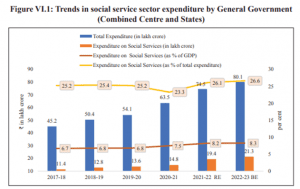
- The share of expenditure on health in the total expenditure on social services, has increased from 21 per cent in FY19 to 26 per cent in FY23 (BE).

IMPROVING HUMAN DEVELOPMENT PARAMETERS
- According to United Nations Development Programme (UNDP) report, 90 per cent of countries have registered a reduction in their Human Development Index (HDI) value in 2020 or 2021, indicating that human development across the world has stalled for the first time in 32 years.
- India ranked 132 out of 191 countries and territories in the 2021/2022 HDI report. India’s HDI value of 0.633 in 2021 places the country in the medium human development category, lower than its value of 0.645 in 2019.
- However, India’s HDI value continues to exceed South Asia’s average human development. It has been steadily increasing and moving towards the world average since 1990 due to priority placed on investment in social infrastructure, including ensuring universal health and education.
- On the parameter of gender inequality, India’s Gender Inequality Index (GII) value is 0.490 in 2021 and is ranked 122. This score is better than that of the South Asian region.
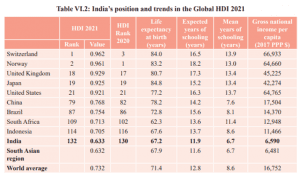
UNDP Multidimensional Poverty Index 2022
- Multidimensional poverty measures are used to create a more comprehensive picture. It reveals who is poor and how they are poor, and the range of different deprivations experienced by them.
- The 2022 report of the UNDP on MPI was released in October 2022 and covers 111 developing countries.

TRANSFORMATION OF ASPIRATIONAL DISTRICTS PROGRAMME
- The Government of India launched the ‘Transformation of Aspirational Districts’ (Aspirational Districts Programme (ADP)) initiative in January 2018 with a vision of a New India by 2022 wherein the focus is to raise living standards of its citizens and ensuring inclusive growth of all in the burgeoning economy.
- Aspirational Districts (ADs) across 28 States/UTs have been identified by NITI Aayog based upon composite indicators ranging from health and nutrition, education, agriculture, and water resources, financial inclusion and skill development, and basic infrastructure which have an impact on HDI.
- The Aspirational Districts Programme has emerged as a template for good governance, especially in remote and difficult areas.
- At present, two programmes have been conceptualized along the lines of ADP design, one is ‘Mission Utkarsh’ and the other is ‘Aspirational Blocks Programme’ (ABP).
PROGRESSING LABOUR REFORM MEASURES
- In 2019 and 2020, 29 Central Labour Laws were amalgamated, rationalized, and simplified into four Labour Codes, viz., the Code on Wages, 2019 (August 2019), the Industrial Relations Code, 2020, the Code on Social Security, 2020, and the Occupational Safety, Health & Working Conditions Code, 2020 (September 2020).
- The new laws are in tune with the changing labour market trends and, at the same time, accommodate the minimum wage requirement and welfare needs of the unorganized sector workers, including the self-employed and migrant workers, within the legislation framework.
- Rules made under the Codes have been entrusted to Central Government, State Government and at appropriate level.

e-Shram portal
- Ministry of Labour and Employment (MoLE) has developed eShram portal for creating a National database of unorganized workers, which is verified with Aadhaar.
- As on 31 December 2022, total over 28.5 crore unorganized workers have been registered on eShram portal.
AADHAAR: THE MANY ACHIEVEMENTS OF THE UNIQUE IDENTITY
Achievements of Aadhaar
- Aadhaar is an essential tool for social delivery by the State. 318 Central schemes and over 720 state DBT schemes are notified under section 7 of the Aadhaar Act, 2016, and all these schemes use Aadhaar for targeted delivery of financial services, subsidies, and benefits. Aadhaar is the foundation of India’s digital integration.
- JAM (Jan-Dhan, Aadhaar, and Mobile) trinity, combined with the power of DBT, has brought the marginalized sections of society into the formal financial system, revolutionizing the path of transparent and accountable governance by empowering the people.
- Aadhaar played a vital role in developing the Co-WIN platform and in the transparent administration of over 2 billion vaccine doses.
IMPROVING EMPLOYMENT TRENDS
- Labour markets have recovered beyond pre-Covid levels, in both urban and rural areas, with unemployment rates falling from 5.8 per cent in 2018-19 to 4.2 per cent in 2020-21, and a noticeable rise in rural FLFPR from 19.7 per cent in 2018-19 to 27.7 per cent in 2020-21.
- More recent urban employment data shows progress beyond pre-pandemic levels as the unemployment rate declined from 8.3 per cent in July-September 2019 to 7.2 per cent in July-September 2022.
SUPPLY SIDE OF EMPLOYMENT
- The labour force participation rate (LFPR), worker population ratio (WPR) and unemployment rate (UR) in PLFS 2020-21(July-June) have improved for both males and females in both rural and urban areas compared to PLFS 2019-20 and 2018-19.

- Quarterly urban unemployment rate declined from pre-pandemic level of 8.3 per cent in July-September 2019 to 7.2 per cent in July-September 2022, accompanied by a rise in LFPR from 47.3 per cent to 47.9 per cent during the same period, as discussed in paraghaphs 6.33 and 6.34.
- The share of self-employed increased and that of regular wage/salaried workers declined in 2020-21 vis-à-vis 2019-20, driven by trend in both rural and urban areas. The share of casual labour declined slightly, driven by rural areas.
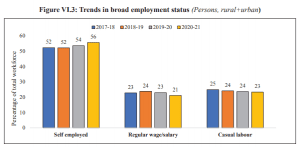
Quarterly PLFS for urban areas
- An improvement in all the key labour market indicators in the quarter ending September 2022 both sequentially and over the last year. The labour participation rate increased to 47.9 per cent in July-September 2022 from 46.9 per cent a year ago
DEMAND SIDE OF EMPLOYMENT
- The estimated total employment in the nine selected sectors according to the fourth round of QES (January to March 2022) stood at 3.2 crore, which is nearly ten lakh higher than the estimated employment from the first round of QES (April-June 2021).

FORMAL EMPLOYMENT
- EPFO data indicates a consistent YoY increase in payroll addition, pointing towards improved formalization as economic activities picked up. The net addition in EPF subscriptions during FY22 was 58.7 per cent higher than in FY21 and 55.7 per cent higher than that in the pre-pandemic year 2019. In FY23, net average monthly subscribers added under EPFO increased from 8.8 lakh in April-November 2021 to 13.2 lakh in April-November 2022.
DEMAND FOR WORK UNDER MGNREGS
- The number of persons demanding work under MGNREGS was seen to be trending around pre-pandemic levels from July to November 2022.
- In FY23, as on 24 January 2023, 6.49 crore households demanded employment under MGNREGS, and 6.48 crore households were offered employment out of which 5.7 crore availed employment.
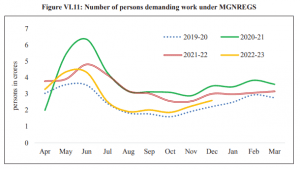
THE TREND IN RURAL WAGES
- Nominal rural wages have increased at a steady positive rate during FY23 (till November 2022). In agriculture, the YoY rate of growth of nominal wage rates in agriculture was 5.1 per cent for men and 7.5 per cent for women, during the period April-November 2022.
ENSURING QUALITY EDUCATION FOR ALL
- The NEP 2020 was laid down as the first education policy of the 21st century, aiming to address the many growing developmental imperatives of the country.
- This includes regulation and governance, creation of a new system that is aligned with the aspirational goals of 21st century-education, including SDG4, while building upon India’s traditions and value systems.
- It provides for nurturing all-around development and skill acquisition by youth in an inclusive, accessible, and multilingual set-up.
SCHOOL ENROLMENT
- The year FY22 saw improvement in Gross Enrolment Ratios (GER) in schools and improvement in gender parity. GER in the primary-enrolment in class I to V as a percentage of the population in age 6 to 10 years – for girls as well as boys have improved in FY22.
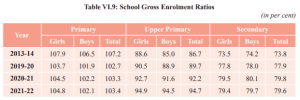
SCHOOL DROP-OUT
- School dropout rates at all levels have witnessed a steady decline in recent years. The decline is for both girls and boys.
- The schemes such as Samagra Shiksha, RTE Act, improvement in school infrastructure and facilities, residential hostel buildings, availability of teachers, regular training of teachers, free textbooks, uniforms for children, Kasturba Gandhi Balika Vidyalaya and the PM POSHAN Scheme play an important role in enhancing enrolment and retention of children in schools.

HIGHER EDUCATION
- The total enrolment in higher education has increased to nearly 4.1 crore in FY21 from 3.9 crore in FY20. Since FY15, there has been an increase of around 72 lakh in enrolment (21 per cent). The female enrolment has increased to 2.0 crore in FY21 from 1.9 crore in FY20.

Initiatives for higher education
- Research & Development Cell (RDC) in Higher Education Institutions (HEI)
- Guidelines for pursuing two academic programmes simultaneously
- Interest subsidy on education loan
EQUIPPING THE WORKFORCE WITH EMPLOYABLE SKILLS AND KNOWLEDGE IN MISSION
- Skill development is aimed at the removal of the disconnect between demand and supply of skilled manpower, building vocational and technical training framework, skill up-gradation, and building of new skills, and innovative thinking not only for existing jobs but also jobs of the future.
- In order to address the incremental manpower requirement and to empower youth with adequate skills, the Ministry of Skill Development and Entrepreneurship (MSDE) was created in 2014 and Skill India Mission was launched in 2015.
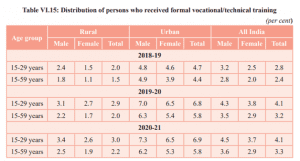
- The Skill India Mission focuses on skilling, re-skilling and up-skilling through short term and long term training programmes. Under the Mission, the government, through more than 20 Central Ministries/Departments, is implementing various skill development schemes across the country.
QUALITY AND AFFORDABLE HEALTH FOR ALL
Ensuring the provision of quality health facilities to citizens is an important priority for the Government. Towards this objective, multidimensional initiatives have been launched and carried forward for better overall health of the citizens.
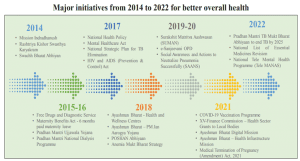
- With concerted efforts made under the Reproductive, Maternal, New-born, Child, Adolescent Health Plus Nutrition (RMNCAH+N) strategy, India has made considerable progress in improving the health status of both mothers and children.
- As per the Sample Registration System (SRS) data, India has successfully achieved the major milestone to bring the Maternal Mortality Ratio (MMR) to below 100 per lakh live births by 2020 (laid down in National Health Policy 2017) by bringing it down to 97 per lakh live births in 2018-20 from 130 per lakh live births in 2014-16.
- Eight states have already achieved the SDG target to reduce MMR to less than 70 per lakh live births by 2030. These include Kerala (19), Maharashtra (33), Telangana (43) Andhra Pradesh (45), Tamil Nadu (54), Jharkhand (56), Gujarat (57), and Karnataka (69).
- Following a steady downward trend, Infant Mortality Rate (IMR), Under Five Mortality Rate (U5MR) and Neonatal Mortality Rate (NMR) have further declined as a result of countrywide efforts towards increasing health service coverage through strengthening of service delivery; quality assurance; RMNCAH+N; human resources, community processes; information and knowledge; drugs and diagnostics, and supply chain management, etc.
HEALTH EXPENDITURE ESTIMATES
- The NHA estimates for FY19 show that there has been an increase in the share of Government Health Expenditure (GHE) in the total GDP from 1.2 per cent in FY14 to 1.3 per cent in FY19.
- Overall, for FY19, THE for India is estimated to be `5,96,440 crore (3.2 per cent of GDP and `4,470 per capita).
- The social security expenditure on health, which includes the social health insurance programme, government-financed health insurance schemes, and medical reimbursements made to government employees, has increased from 6 per cent in FY14 to 9.6 per cent in FY19.
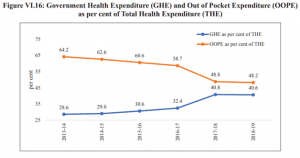
Rural health care – strengthening of infrastructure and human resource
- The recent health sector reforms in India have laid emphasis on strengthening health infrastructure as well as human resource in the public sector system.
- This can be observed in the rise in the number of Sub-centres (SCs), Primary Health Centres (PHCs), and Community Health Centres (CHCs) in rural areas, along with the rise in doctors, nurses, and other medical personnel over time.

PROGRESS UNDER MAJOR GOVERNMENT INITIATIVES FOR HEALTH
Immunization
- To reinforce universal immunization, Mission Indradhanush (MI) was launched in December 2014 with the aim to rapidly increase full immunization coverage of children to 90 per cent and sustain it thereafter.
eSanjeevani (Tele-medicine)
- At present, eSanjeevani is operational in all states and UTs across India. As of 17 January 2923, 1,12,553 HWCs in rural areas and 15,465 Hubs at tertiary level hospitals, and medical colleges in the states have been enabled in the eSanjeevani.
NATIONAL COVID-19 VACCINATION PROGRAMME
- More than 220 crore COVID vaccine doses administered as on 06 January, 2023.
- 97 per cent of eligible beneficiaries have already received at least one dose of Covid-19 vaccine and around 90 per cent of eligible beneficiaries have received both the doses. Vaccination for the age group 12-14 years was started on 16 March 2022, followed by the precautionary dose for the age group 18-59 years starting from 10 April 2022.
AYUSHMAN BHARAT
- Nearly 22 crore beneficiaries have been verified under the Ayushman Bharat Scheme as on 04 January, 2023. Over 1.54 lakh Health and Wellness Centres have been operationalized across the country under Ayushman Bharat.
THE CONCLUSION AND THE WAY FORWARD
- Today, India is moving towards the attainment of the UN SDGs. While doing so, it is cognisant of the fact that for equitable development, a country as vast and diverse as India requires the implementation of broad-based inclusive social policies, supported by adequate and commensurate financial resources. Thus, the character and contour of such an approach to development presents a unique set of challenges which is consistently being addressed in the form of mindful reforms.
- Ensuring that intended outcomes of social sector development schemes reach the intended, involvement of the grassroot level of governance is imperative and is being actively pursued.
- Technology has been a great enabler in ensuring the last-mile connectivity of government schemes to the targeted citizens. It has revolutionized the delivery of services while ensuring transparency and accountability. It needs to be harnessed further to help the government attain the lofty SDGs on the social front.
- As India marches ahead, the ground lost as regards social sector improvements due to the pandemic, has largely been recouped, powered by prompt policymaking and efficient implementation interwoven with technology.
- Going forward with the vision of ‘Minimum Government; Maximum Governance’, further developments will hold the key to attaining more equitable economic growth.
- Evident ones include stepping up learning outcomes through digital and teaching interventions in schools, enhancing the role of community workers in healthcare, pushing SHGs through better product design and upscaling enterprises.
- Further, channelizing women’s economic potential through ecosystem services such as affordable market alternatives for care work, safe transportation and lodging, and long-term counselling support, can help capitalize the gender dividend for the country’s future economic and social development.

